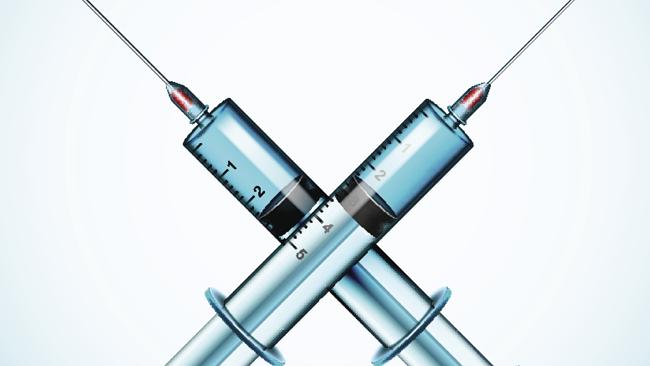
Problematic … Doctors are using high-dose local anaesthetic without any training or resuscitation equipment. Picture: News Corp Australia Source: News Limited
DOCTORS with no specialist training in anaesthetics are allowed to provide high doses of local anaesthetic during cosmetic surgery, even though there is a risk of life threatening complications.
And there is no requirement they have defibrillators or breathing apparatus to revive a patient if the surgery takes place in their rooms putting patients at even greater risk.
The high risk and unregulated use of pain relief came to light after a young woman suffered a cardiac arrest while having a breast enlargement under local anaesthetic in Sydney earlier this year.
She survived because the clinic treating her had voluntarily installed resuscitation equipment including a cardiac defibrillator and emergency drugs.
However, experts are concerned some office-based cosmetic clinics don’t have this equipment and that often the same doctor who is doing the surgery is also in charge of the sedation when cosmetic surgery is performed.

Danger … One Sydney cosmetic surgery patient had a cardiac arrest linked to local anaesthetic. Picture: Supplied Source: ThinkStock
One Sydney cosmetic surgeon says in a Youtube video he arouses patients under sedation during procedure and asks for their consent about the size of the breasts implants they get.
This is even though the Australian New Zealand College of Anaesthetists (ANZCA) says patient consent can’t be given while they are under any form of sedation.
ANZCA is now pushing for training in the use of local anaesthetics for cosmetic surgeons and says facilities should to be licensed and audited.
Phillipa Hore, the chair of ANZCA’s safety and quality committee, says cosmetic surgeons can provide local anaesthetic without any training, even though an excessive dose has the potential to cause convulsions or cardiac arrest.
There is no requirement to report any complications and there is no audit of such complications, she says.
“It’s difficult to understand that in our sophisticated society with world class medical care there, is this practice going on over which there is no regulatory control and the patient is not aware,” she said.

Regulation … The college of anaesthetists wants training in the use of local anaesthetics to be mandatory. Picture: Supplied Source: Supplied
Facilities providing high dose local anaesthetics should have a defibrillator and equipment to support the patient’s breathing if there is a complication, Dr Hore says.
The Australian Society of Plastic Surgeons (ASPS) has also taken aim at “office-based cosmetic surgery” in its submission to a medical board inquiry into cosmetic surgery.
ASPS President, Associate Professor Hugh Bartholomeusz OAM RFD says his society been lobbying state governments to change the regulations for two years.
“Do we have to wait for people to die before they do something?’ he asks.
He says the requirements on infection control, quality, auditing, resuscitation equipment that apply to day hospitals should be applied to office based surgeries.
The rules allowing GPs and other doctors to provide local anaesthetic without training was originally so they could use low doses to stitch small wounds or remove skin lesions.
“Cosmetic procedures are much larger procedures but they are being done under local anaesthetic,” Dr Hore said.

Change … Rules around local anaesthetic were originally lax because they were only used for minor procedures. But now they are being used for bigger operations, such as breast implants. Picture: Supplied Source: Supplied
A fully qualified anaesthetist has to undergo seven years training and must report adverse events to state based data bases.
The lack of regulation of anaesthetics care has come to light after News Corp revealed earlier this month that there was no formal training requirement for cosmetic surgeons. Any doctor straight out of medical school can call themselves a cosmetic surgeon.
The issue is a growing concern as cut price breast enlargements in Australia have now become price competitive with cosmetic surgery in Thailand boosting the number of surgeries taking place in Australia.
A young woman, Amy Rickhuss, who had cosmetic surgery at The Cosmetic Institute Sydney earlier this year had a cardiac arrest that was attributed to the local anaesthetic used during the procedure.

Survivor … Amy Lee Rickhuss suffered a cardiac arrest during a cosmetic surgery procedure. Picture: Facebook Source: Facebook
The Cosmetic Institute refused to answer News Corp’s detailed questions about the incident.
However, managing director David Segal says “there is a specialist anaesthetist present throughout every procedure undertaken at TCI”.
The Cosmetic Institute uses a combination of twilight anaesthesia and local anaesthetic during breast implants.
He said the institute has “a full range of emergency equipment that meets all requirements stipulated by professional bodies such as the Australia and New Zealand College of Anaesthetists”.
“Each facility has two fully equipped resuscitation trolleys with all airway equipment, cardiac defibrillators and emergency drugs,” he said.
The institute does not report any incidents to external bodies but reviews them according to its quality management system, he said
